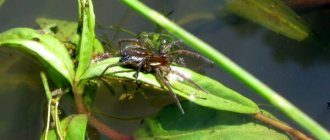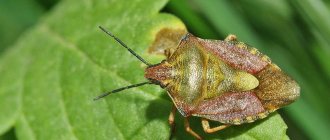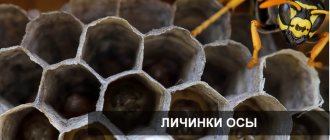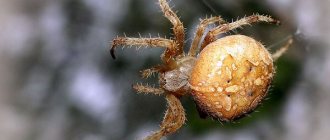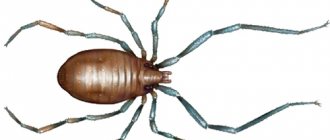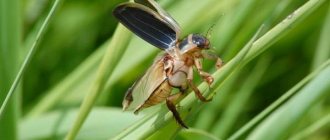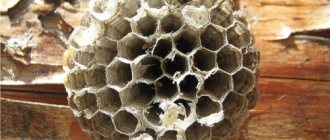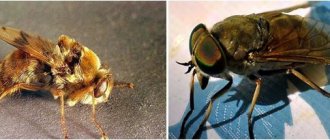The water scorpion (Latin Nepidae, scientific Nepidae Latreille) belongs to the family of aquatic bugs. There are about 230 species in total. The length generally varies from 1.7 to 4.5 cm, the body is flat and oval in gray-brown color. In some individuals, the abdomen is painted in bright colors. At the rear end there is a breathing tube, and on the head there are special antennas, and the eyes are faceted. The character is predatory. With the help of powerful paws, they pounce on the victim, biting with their proboscis. Such a foot can hold 15 times the weight of a water strider on the surface of the water. They have wings to the end of the body.
They move slowly, usually just waiting for prey in the water and pouncing on it. They can wait for a victim in this way for hours. Outwardly, they look like an old leaf, which allows them to remain invisible.
On the legs and abdomen there are sensory organs that provide balance. Bed bugs rarely leave their home body of water, only if they sense the danger of drying out.
Their peculiarity is breathing. With the help of a breathing tube, which they raise above the surface, air enters the abdominal spiracles and then into the space under the wings. This way they store oxygen.
IMPORTANT! Scorpions cannot fly and are extremely poor swimmers. That is why they live only in stagnant water, buried deep in plants.
Habitat
They live mainly in Asia, Africa and Europe in fresh, standing water. Only a few species are found in Russia. Particular preference is given to warm water - ideally 25-30 degrees. But there are several species that have adapted to salty sea water.
The main species found in Russia:
- Water strider. The most popular type. Found in almost all bodies of water.
- Gladysh. Another name is water wasp, as it stings quite painfully.
- Greblyak. They like to fly out of the water abruptly, scaring those around them.
- Belostoma. The largest individual is maximum 17 cm.
In winter, bedbugs move to dry land in moss, grass or foliage. But if someone did not have time to hide, he does not die. They can also overwinter in air bubbles in the ice.
Invisible insects
These insects are not distinguished by sufficient mobility; they are not in too much of a hurry when moving from place to place. In addition, compared to other beetles that inhabit the pond, bedbugs swim very poorly. Consequently, in order to satisfy the need for food, the water scorpion has no choice but to sit on some plant and wait for the moment when the prey itself approaches. The water scorpion has wings that are not fully used, since they are very poorly developed.
Due to the characteristic concealing color of the water scorpion, it is almost impossible to immediately notice among plants - it differs little from a leaf floating on the water. Disguise only benefits the water scorpion. Spending most of the time in a motionless state, on the one hand, it remains unnoticed by enemies, and on the other, it helps to hunt easily.
What does it eat?
Small species try to hunt animals that are smaller than them. They swim quickly, catching up with the prey. But larger ones prefer to hide deep in the shelter and wait for their prey there.
Insects cannot swallow hard and tough food. They mainly consume larvae, small insects, eggs and tadpoles. If the season of hunger comes, then bedbugs can hunt each other.
Water scorpions, holding their prey tightly, dig into their body and suck out all the nutrients. Their body contains poison, which paralyzes the victim. In this case, the victims experience real torment. Even if a person is in pain from an insect bite, then a tadpole is even more so.
Description
The common water scorpion is an insect with a length of 1.7 to 4.5 cm. The body is flat, wide, with two respiratory tubes at the end of the abdomen. The triangular head contains antennae, compound eyes and a sharp sucking proboscis. The forelimbs are very powerful, reminiscent of scorpion claws, and are designed to grab prey. Body color ranges from dark gray to gray-brown. The abdomen is red above, with a black base and end. The wings are smoky, with red or yellowish veins. Thanks to mimicry, it is very difficult to see the insect: it looks like a wet and slightly rotten fallen leaf.
Reproduction
The process of reproduction in individuals begins in the fall and in the first days of spring. Males use their hook-shaped antennae to restrict the female's movements and successfully mate with her.
The female lays up to 20 fairly large eggs, attaching them to the leaves with flagella.
Some species lay larvae on the male. A young father carries his children for up to two weeks. At this time he does not hunt and leads a sedentary lifestyle.
IMPORTANT! Some "fathers" die of exhaustion in the end. They care so much about their offspring.
During the entire period of maturation, the larvae molt up to 5 times, gradually increasing in size. The final molt comes in the winter, into which the bug enters the body of an adult. After awakening, he is ready for independent life.
Larvae
The larvae themselves do not pose any harm.
And there are scorpions in the water
Scorpios are not to be trifled with, everyone knows that – they will bite you so hard that you won’t think it’s enough.
As for its aquatic namesake, this little scorpion, one and a half to two centimeters long, is not scary to humans, because although it can bite, it does no harm, only tickles. And the water scorpion, listed in the Red Book of the Republic of Tatarstan, received its formidable name because its body shape resembles a real one. The similarity is also given by two front legs bent like claws and a seemingly chopped off head, armed with a sharp proboscis. Some people consider this insect disgusting: it is a bug, dirty-sandy in color from the dirt that has stuck to it, crawling along the soft green stem of a plant. But to me he even seems attractive with his bulging dark eyes and small mustache - a sort of stylized man in a zipun.
By the way, the water scorpion (Nepa cinerea) is one of the most original bugs.
Its coloring is simple - brown or brown, but it is thanks to this that the water scorpion can perfectly pretend to be a fallen dry leaf. The phenomenon is called mimicry, and few insects possess such art.
The water scorpio does not like large companies and prefers loneliness. In the summer, he is actively involved in his own affairs, including “family” ones, and spends the winter in the water: he sits at the bottom of the reservoir and watches for prey. Its front legs, like the blade of a penknife, are able to fit into the groove on the inside of the thigh. There is also a “hook” to which the foot clings when the “pen holder” is folded. The front legs of a water scorpion, resembling claws, deftly capture prey (small insects and their larvae, leeches) and bring them to the mouthparts. By piercing the victim with its sharp proboscis, the bug sucks out the nutritious juices from it. Its four more legs, covered with hairs, are designed for movement and swimming. Although the swimmer of the water scorpion is unimportant, he is much better at walking, as well as flying - he is able to get from one body of water to another by air.
But the most interesting thing about the water scorpion is its tail, up to 10 mm long. It consists of two appendages similar to thin hairs, capable of being tightly connected to each other at a certain moment, forming a kind of tube or siphon. By placing this device out of the water, the water scorpion thus fills itself with air and breathes.
At the beginning of summer, the female lays about 20 eggs on the leaves of aquatic plants. Each of them has spikes through which air flows. By the way, they also protect from enemies. After about two weeks, larvae appear, similar to the adult, with the only difference that they do not yet have a long breathing tube. Their exit from the egg is interesting: when the time comes, the cap equipped with spines opens under the pressure of the larva’s head, and the “baby” crawls out. He gets to the water by crawling on plants. Water scorpion larvae can be found most often in August among pea and pinnate branches floating on the surface of the water.
Professor, Doctor of Biological Sciences, author of many scientific articles on aquatic invertebrates Valery Yakovlev, who has worked for many years in the field of hydrobiology, ecology and aquatic toxicology, has more than once observed water scorpions in the mouth of the Kazanka, on lakes Beloe and Krugloye in Raifa, as well as in rivers Maly and Bolshoi Cheremshan. In his opinion, although these bugs are of no practical importance and even to some extent harm fish farming by eating fry, they are also very useful. Because water scorpions actively eat mosquito larvae and pupae and are able to sharply reduce the number of blood-sucking insects in water bodies.
In the Red Book of the Republic of Tatarstan, the water scorpion is listed as a species that is recovering, but requires constant monitoring. It is harmed by turbidity, siltation of water bodies, and destruction of vegetation by livestock at watering places. The closest relative of the water scorpion, the slender Ranatra rod-shaped, similar to a thin branch, also listed in the Red Book of the Republic of Tatarstan, has exactly the same complaints about water quality.
“When ranatra sits on a plant or is in water, it is almost impossible to notice,” says Valery Yakovlev. “And only the large, club-shaped eyes betray the presence of an insect.” Ranatra is inactive and likes to hang upside down, thus setting up an ambush. She is quite a greedy insect. Even when full, it continues to catch prey and can grab two victims at the same time. Once caught, for example in a net, the ranatra becomes motionless. She pretends to be dead even when her limbs are torn off. But as soon as it hits the water, it quickly swims away. At night, ranatras can fly from one body of water to another.
Interestingly, ranatras are able to live in home aquariums, but provided that they are tightly closed with lids at night. Otherwise they will fly away...
Does it bite?
Water bugs have a sharp piercing apparatus. They can easily bite through human skin. They also contain poison, but it is absolutely safe for humans.
The bug almost never attacks itself . It is better not to pick him up or touch him. But if it is touched, a red spot forms at the site of the bite. As a treatment, you can lubricate it with iodine or brilliant green.
But in the tropics there are more terrible creatures. Their poison can already cause an allergic reaction. These species have a very long sting that penetrates deeply and causes severe pain. The burning sensation can last up to 30 minutes. Traces remain for up to one week. But there are no deaths. Still, it is not recommended to touch these insects.
A little about the life of a water scorpion
The water scorpion (Nepa cinerea L.) belongs to the family of water scorpions (Nepidae), order of bugs (Hemiptera). He is the most original bug. Its shape is unusual: it resembles a rotten leaf and looks very similar to a scorpion (hence the name).
Water scorpion.
The water scorpion prefers bodies of water with slowly flowing or standing water, densely overgrown with aquatic vegetation, on which it mainly rests. In the coastal zone of flowing reservoirs - streams and rivers, its larvae are found mainly. They fight the current with the help of tenacious legs, with which water scorpions cling to aquatic plants.
Water scorpion (Nepa cinerea). 1 - adult individual 2. Head, prothorax, as well as the 1st pair of legs. 3. Nepa cinerea: respiratory tube from the abdominal side (right); tip of the larval breathing tube; cross section through the respiratory tube of an adult and larva (top). 4. Nepa cinerea mating. 5. Nepa cinerea larvae of the 1st and 5th stages. 6. Abdomen of Nepa cinerea larva from below.
Nepa cinerea is a slow-moving animal that moves through plants by clinging to them with its small claws. He swims reluctantly and poorly. Among other aquatic bugs, he is the weakest swimmer. Basically, Nepa cinerea sits motionless on aquatic plants and watches for its prey. It should be noted that the water scorpion has developed wings.
In shape and color, the aquatic scorpion is very similar to a dead leaf that has fallen into the water (a phenomenon of mimicry), which allows it to remain unnoticed by both potential enemies and prey. Having noticed the victim, the bug quickly throws out the front pair of limbs and grabs its prey. Having squeezed its prey, as if in a vice, the scorpion sucks it out with the help of a sharp, meek, jointed proboscis.
Nepa cinerea larva.
The bug's proboscis is strong and sharp enough that it can easily pierce human skin, which means that the injection can be quite painful. Nepa cinerea breathes atmospheric air using a long tube-like process located at the back of the body. The scorpion puts the end of this tube out of the water and takes in air, which is then carried into the spiracles of the abdomen. Aquatic scorpions reproduce with the help of eggs, which (at the beginning of summer) the female lays on aquatic plants. The larvae that emerge from the eggs are very similar to the adults, the only difference being that they do not yet have a long breathing tube.
What does a water bug look like? General features of the structure. Close-up photo
Despite the presence of numerous features, a number of characteristics can be identified that make it possible to distinguish bedbugs living in water bodies from representatives of other species of this order. These include:
- significant length of the body and limbs;
- 1 pair of antennae, which increases the chances of finding prey, since they act as highly sensitive antennas;
- organs of vision (available in most water bugs);
- body shape oval, posterior end pointed;
- the body is flat;
- there are wings;
- short forelimbs - they perform a grasping function, since almost all individuals of this group are predators.
The color of the water bug is most often dark (black, brown), which allows the insects to go unnoticed.
Morphology
The head is characterized by the presence of a clearly visible piercing-sucking oral apparatus. A fairly strong and hard proboscis is pressed against the abdomen of the insect, capable of piercing human skin or the integument of insects.
It is for the painful bites that an arthropod such as the water bug is often called the “water wasp.”
On the chest of the water bug there are three pairs of legs, one of which is a paddle leg, longer and more powerful than the others, densely covered with bristles and used for movement in the water column.
Bedbugs move very clumsily on the ground, grabbing onto any uneven surfaces with their pair of front legs.
The insect's abdomen is represented by seven segments, occupying approximately ¾ of the total body length of the arthropod. The abdomen is covered from the back by elytra. The dorsal part of the body is convex, with a keel, and the ventral part is flattened.
The giant water bug is found mainly in southern countries. An arthropod water insect with eggs on its back has a very unusual appearance.
It is noteworthy that with such a burden in the form of future offspring, male bugs live until the larvae are born, about two weeks.
Stages of development
Eggs are laid by females in the last month of spring, when at the bottom of reservoirs, under stones and large leaves of plants, light yellow offspring of the bug, similar to beads, can be found.
The rate at which eggs ripen directly depends on the temperature of the water, but most often the whole process takes only two weeks.
The maturation of the newly born bedbug larvae lasts until the onset of autumn, but during the summer such insects manage to molt approximately four times.
Habitat
They live mainly in Asia, Africa and Europe in fresh, standing water. Only a few species are found in Russia. Particular preference is given to warm water - ideally 25-30 degrees. But there are several species that have adapted to salty sea water.
The main species found in Russia:
- Water strider. The most popular type. Found in almost all bodies of water.
- Gladysh. Another name is water wasp, as it stings quite painfully.
- Greblyak. They like to fly out of the water abruptly, scaring those around them.
- Belostoma. The largest individual is maximum 17 cm.
In winter, bedbugs move to dry land in moss, grass or foliage. But if someone did not have time to hide, he does not die. They can also overwinter in air bubbles in the ice.
Breathing water scorpions
The insect breathes atmospheric air. The respiratory process occurs thanks to a long process. In an adult insect, such an organ can be found in the back of its body. It has the shape of a tube, which consists of 2 grooves facing each other. Air enters the appendage after its end emerges from under the water. Moving along the respiratory tube, the air first accumulates in a closed space located under the wings, and then goes to the abdominal spiracles. Unlike adults, larvae, instead of a respiratory siphon, which they lack, use small processes for breathing. Such a process, located at the end of the larva’s body, allows it to spend the necessary time immersed under water.
0
0
Variety of species
About 230 species have been described, grouped into 14 genera and 2 subfamilies; only 2 species live in central Russia.
What does it eat?
Small species try to hunt animals that are smaller than them. They swim quickly, catching up with the prey. But larger ones prefer to hide deep in the shelter and wait for their prey there.
Insects cannot swallow hard and tough food. They mainly consume larvae, small insects, eggs and tadpoles. If the season of hunger comes, then bedbugs can hunt each other.
Water scorpions, holding their prey tightly, dig into their body and suck out all the nutrients. Their body contains poison, which paralyzes the victim. In this case, the victims experience real torment. Even if a person is in pain from an insect bite, then a tadpole is even more so.
Reproduction
The process of reproduction in individuals begins in the fall and in the first days of spring. Males use their hook-shaped antennae to restrict the female's movements and successfully mate with her.
The female lays up to 20 fairly large eggs, attaching them to the leaves with flagella.
Some species lay larvae on the male. A young father carries his children for up to two weeks. At this time he does not hunt and leads a sedentary lifestyle.
IMPORTANT! Some "fathers" die of exhaustion in the end. They care so much about their offspring.
During the entire period of maturation, the larvae molt up to 5 times, gradually increasing in size. The final molt comes in the winter, into which the bug enters the body of an adult. After awakening, he is ready for independent life.
Fighting methods
Bedbugs are not so dangerous that they need to be exterminated. And in some places it is even prohibited. Therefore, there are neither chemicals nor folk remedies to combat them. But they also have their enemies.
Natural enemies
Water scorpions are eaten by larger fish. During periods of hunger, scorpions can eat each other.
But in Thailand, these scorpions are a real delicacy. And their enemy is man. They are caught en masse, fried and eaten. Anyone can enjoy this dish.
IMPORTANT! Difficulties await Scorpios at every turn. They usually live no more than two years, because even frost can kill them. But in laboratories, individuals live up to 5 years.
Etymology of the name
This insect really looks like a scorpion - a representative of the arachnid class. This is especially evident in the structure of the limbs. The two front legs of the insect are curved like claws. The water scorpion (the photo shows its external structure) has an unusually shaped head. It seems to have been chopped off and bears a trunk-shaped outgrowth. These features of visual similarity determined the name of the water scorpion.
Interesting Facts
- In tropical countries live huge bugs, whose sizes reach 17 centimeters. Locals call them "Alligator Ticks";
- some adults cannot breathe underwater. They are forced to rise to the surface;
- in 2002, a huge canister covered with 70 thousand eggs in several layers was discovered in the tropical Pacific Ocean. Since one female cannot lay more than 20 pieces, this means that the canister was used by several thousand females at the same time;
- water scorpions are able to send some kind of signals. The sound resembles the chirping of a grasshopper;
- water striders that can glide across the surface of the water are called Jesus bugs;
- frightened bugs always try to flee to the north;
- During mating, some species are able to store sperm after mating and reuse it.
Variety of species
About 230 species have been described, grouped into 14 genera and 2 subfamilies; only 2 species live in central Russia.
Who can be confused with
In nature there are many different insects that are similar to each other. This concept even has a term - mimicry.
Water bugs can be confused with the following insects:
| Cockroaches | They have a similar shell, coloring and head. Only the bugs bite painfully. |
| Garden bugs | Outwardly, they are very similar to each other, but the size of garden ones is several times smaller. |
Prevention
As a precaution, remember a few rules:
- Do not touch, handle, or look at water bugs. You should not provoke a bite.
- If you are bitten, don't panic. The bite is not fatal, and ordinary iodine or brilliant green will cope with it.
- If you suddenly find yourself in the tropics, do not touch the bedbugs with your hands.
Sources
- https://zooeco.com/int/int-nasek22-10.html
- https://animalzoom.ru/vodyanoy-skorpion-obyknovennyy
- https://masterklop.ru/vodyanoj-skorpion/
- https://simple-fauna.ru/wild-animals/vodyanoj-skorpion/
- https://dogzy.ru/homyaki/vodnyj-skorpion.html
- https://fishki.net/2175857-vodjanoj-skorpion-nepa-cinerea.html
- https://ZooBot.ru/vodyanoj-skorpion-nepa-cinerea
- https://animalreader.ru/vodyanoy-skorpion-presnovodnyiy-klop.html
